Road traffic crashes constitute a considerable public health burden and represent the eighth leading cause of death, and tenth leading cause of disability adjusted life years (DALYs), globally1,2. The incidence of deaths from road crashes has increased dramatically over the past two decades. According to the 2010 Global Burden of Disease study, there was a 46% rise in deaths worldwide from traffic accidents between 1990 and 20103. Current trends suggest that unless action is taken, by 2030 road traffic crashes will be the fifth leading cause of death and fourth leading cause of burden of disease1,4. Burden of disease is a measurement of the relative impact of different diseases and injuries on populations by quantifying the number of years lost to a disease or injury. The measurement takes into account years of life lost, the quality of years lived, associated morbidity, mortality and financial cost5. Recognising this, in 2010 the United Nations General Assembly declared a Decade of Action for Road Safety6,7.
Given sufficient information on their causes, crashes are largely predictable, and prevention strategies can be developed8,9. However, there is a significant lack of data and little is known about the extent, causes and impact of road crashes in low- and middle-income countries1, including those in the Pacific. A 2012 systematic review conducted by Herman and colleagues, which focused on this issue in Pacific Island countries, identified just 19 studies published between 1980 and 2010, with all but three undertaken in Papua New Guinea10. The data from Papua New Guinea indicated that injuries from road traffic crashes were more frequent amongst young males, that most road crash victims were car passengers or pedestrians, and postulated that alcohol increased the risk of crashes. This study, and the other literature that does exist, suggest that road traffic crashes are a significant but poorly quantified and poorly researched cause of mortality and morbidity in the Pacific Islands10-12.
This lack of data is particularly true for the Solomon Islands, a lower-middle income island nation of almost 600 000 people located to the east of Papua New Guinea13,14. The nation is highly dependent on official development assistance, which accounted for 34% of gross domestic income in 2012. Although there are some urban areas, including the capital, Honiara, 79% of the population lives in rural areas. Transport links are poor, and only 2.4% of roads are paved13,14.
Herman and colleagues found no road traffic crash studies since 1980 reporting data from the country10. WHO's 2013 Global status report on road safety included minimal data coming from the Solomon Islands1. The best available data were from the emergency department at the National Referral Hospital in Honiara, and related to deaths from road traffic crashes in 2010 only. Only 12 deaths from road traffic crashes were recorded in that year. Data were not available to report on trends in road traffic deaths, nor were any data reported on injuries related to road traffic crashes. There is evidently a lack of data related to road traffic crashes being collected, and the small number of recorded fatalities likely suggests that the data that is available is incomplete.
This study aims to address this lack of data. Using records gathered by the orthopaedic department at the National Referral Hospital, the study provides data on the perceived cause of road traffic crashes, the demographic profile of patients presenting following crashes and the types of injuries sustained by patients presenting to the orthopaedic department with a suspected fracture following a crash.
In this article, the terms 'low-income country', 'lower-middle income country' and 'middle-income country' are used in place of 'developing country'. The World Bank assigns countries an income level bracket based on gross national income per capita; for example, low income countries have a gross national income per capita of USD1045 or less15.
The study is a retrospective record review of a pre-existing, de-identified dataset. A standardised trauma form is completed for all patients who present to the orthopaedic department following a motor vehicle crash. The department does not see all patients who present to the hospital following a crash. Only patients with a suspected fracture, as assessed by a clinician, are referred to the orthopaedic team and present at the department.
The trauma form is designed to collect information related to demographics, including age, sex, date of admission, and diagnosis; the injury, including date of injury, type of injury, whether alcohol was involved, and whether the patient died in hospital; any fractures, including number and location; and any other injuries. A complete list of the information that is captured on the trauma form is shown in Table 1.
Trauma forms are completed by the treating clinician. The trauma form may be filled out following presentation at the emergency department, or upon first visit to the orthopaedic department. Data are entered from the trauma forms into a Microsoft Access database twice weekly by the department secretary. Hard copies of forms are stored in the department.
All injuries are coded according to the external cause of the injury on the trauma form, using one of 27 unique codes. Codes are assigned by the treating clinician based on patient self-report. There are seven codes specifically related to road traffic crashes: 'bicycle', 'car driver', 'car passenger', 'pedestrian', 'motorbike', 'open truck' and 'other'. For example, were a patient to present to the department with an injury after having been knocked off a bicycle, this would be entered into the Access database and assigned the code 'bicycle'.
All patients are asked if alcohol was a contributing factor in their crash. This could mean either that the patient, the driver of the vehicle that they were in or the driver of any other vehicle involved had consumed alcohol. The presence of alcohol is based on self-report, and no testing is undertaken to confirm the reports.
All existing records from the database were de-identified and extracted to Microsoft Excel. Records coded as road traffic injury were then extracted from this larger dataset of fractures due to any cause. Records for presentations prior to 1993 and for 2013 were extracted and removed. The data were checked for duplicate patient files, which were also removed. The clinical notes section for each patient were reviewed, and patient files misclassified as road traffic accidents (caused by another mechanism) were removed. Data were analysed in Microsoft Excel.
Table 1: Data captured on standardised trauma form of orthopaedic department, National Referral Hospital, Honiara
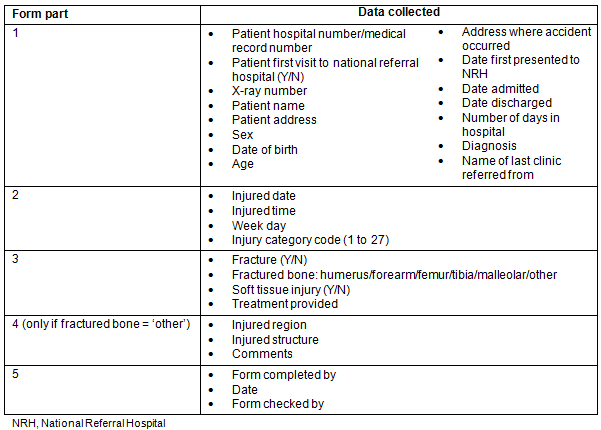
Ethics approval
Ethics approval for this study was granted by the Solomon Islands Ministry of Health Ethics Committee.
The database contained 8095 patient records for 1993-2012, of which 699 (8.6%) were coded as road traffic crashes. The majority of patients (n=516, 73.4%) were from Guadalcanal province, which includes the capital, Honiara, where the hospital is located (Table 2).
Patients presenting to the hospital were most frequently injured whilst a passenger in a car (n=194, 27.8%), as a pedestrian (n=168, 24.0%), and in an open truck (n=151, 21.6%). An open truck is a pickup truck, used in Honiara as a means of mass transit. Passengers sit unrestrained in the open rear cargo area. Thirty-six presentations were classified as 'other'. These were accidents from industrial machinery (tractors or bulldozers, n=11), buses (n=18), or were unspecified (n=7) (Fig1).
Just fewer than three-quarters of all patients seen were male (n=513, 73.1%; sex was unspecified for one patient). Males were the majority of patients seen in all seven coded classes. Children and young adults (139 aged 10-19 years, and 200 aged 20-29 years) accounted for 48.5% of all patients seen (Fig2).
Table 2: Home province of patients presenting to the fracture clinic at the National Referral Hospital, Honiara, 1993-2012
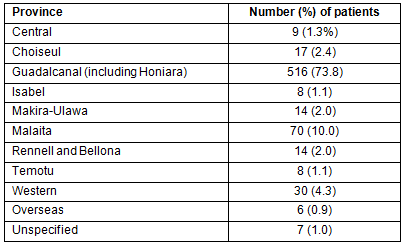
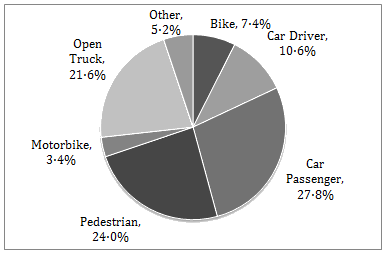
Figure 1: Percentage of recorded road traffic crashes by code, 1993-2012.
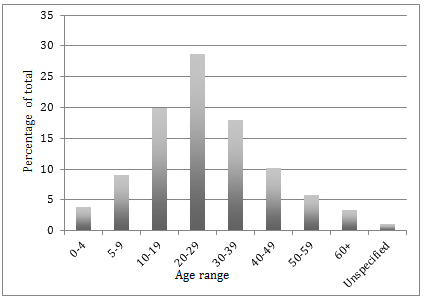
Figure 2: Percentage of patients presenting to the fracture clinic at the National Referral Hospital, Honiara, by age, 1993-2012.
Alcohol as a contributing factor
Almost a quarter of patients (n=166, 23.8%) indicated that alcohol was involved in their crash. Alcohol as a contributing factor was most frequently reported in injuries to car drivers (50.7%) and injuries to motorbike riders (37.5%) (Fig3).
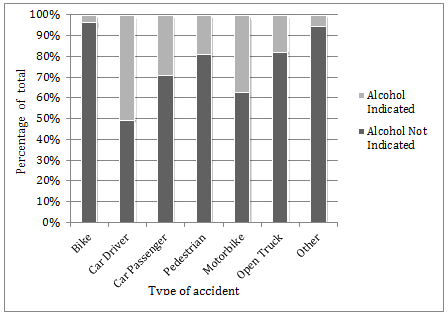
Figure 3: Percentage of accidents, by type of accident, in which alcohol was indicated as a contributing factor, National Referral Hospital, Honiara, 1993-2012.
Presence, location, and extent of fractures
More than two-thirds (n=473, 67.7%) of patients seen presented with at least one fracture. Of those in this database, the presence of a fracture was most common in patients presenting after bicycle (88.5%) and motorbike accidents (75.0%). Fractures of the leg (femur, tibia, malleolus) accounted for 35.5% of all fractures, those of the arm (humerus, radius, ulna) for 33.0%, and those of 'other' (unspecified) bones for 30.7%.
Of all patients seen, 7.9% of patients seen (n=55) presented with two fractures, and 1.1% (n=8) with three. In this database, patients with traumas that were coded as 'car driver' or 'pedestrian' were most likely to present with multiple fractures.
Discussion
This study is one of the first to provide an overview of road traffic crashes in the Solomon Islands. According to the data, patients presenting to the orthopaedic department following a road crash are most likely to be young and male. This is consistent with previously published literature from low- and middle-income countries, which have reported that those aged 15-44 years account for more than half of deaths from road crashes and almost 70% of potential years of life lost, with males frequently overrepresented8,11,15,16.
In this sample, almost half of patients seen were between the ages of 10 and 29 years. If presentations following road traffic crashes were spread evenly across the population, this percentage should be the same as the overall percentage of Solomon Islanders aged between 10 and 29 years. However, according to the 2009 national census this age group accounts for only 38.1% of the total population17, providing additional evidence that children and young adults are overrepresented in crash statistics in the country.
It is concerning that young males are most likely to be involved in crashes resulting in potential injury such as fractures. As has been noted8, young males are in their prime years of productivity. Removing them from the workforce, even if just temporarily, could have serious and long-term socioeconomic consequences.
Nationally, it has been estimated that the direct costs of road crashes are equal to 1.5% of gross national product in middle-income countries, a figure likely to be similar in lower-middle income countries such as the Solomon Islands8. Road traffic crashes may also have consequences for healthcare delivery systems. It has been suggested that there is a lack of critical care resources in the Solomon Islands to treat those injured or with a critical illness18. Prevention programs have the potential to free up these scarce resources.
At the individual level, the costs of long-term care, and loss of income and productivity, are widely recognised8,16. Case studies from India and Bangladesh have shown that road traffic crashes frequently reduce total household income for poor families, push poor families into debt, encourage another family member to give up work to care for the injured, and may reduce both food production and consumption19.
These individual consequences may be especially severe in the Solomon Islands, due in part to the wantok system, which binds extended families together through a set of mutual obligations and reciprocal support20. Whilst the system can provide a social safety net, as members draw on the family for support in times of need, media reports suggest that due to high unemployment and the slow pace of job creation in the Solomon Islands, young men often become the sole breadwinner for a large extended family21. If this single provider becomes incapacitated and unable to work, whole extended families may become economically vulnerable.
The study also revealed that more than half of injuries resulting from road traffic crashes were borne by vulnerable road users. Vulnerable road users are defined as those most at risk in traffic because they are unprotected by an external shield22 and include pedestrians, cyclists and motorcyclists and, in this sample, passengers in open trucks. Any program intending to address road crashes in the country will need to take these users into account, for example by directing money towards building dedicated footpaths for pedestrians or lanes for bicycles. Given the extent of injuries sustained by open truck users, who often use trucks to get to destinations not serviced by buses, there may also be a need to explore expanding safe public transport services.
The absence of previous studies points to a lack of systematic data collection and reporting systems for motor-vehicle-related injury. This is a common occurrence in many low- and middle-income countries8,10 and is of concern, since adequate baseline data are required to facilitate the development of effective and targeted interventions. Many programs are known to reduce the incidence of road crashes, including mandated seatbelts, alcohol breath testing and improvement of public transport infrastructure1,10,16,23. In Malaysia, legislation mandating helmets for motorcycle riders is estimated to have contributed to a 30% reduction in motorcycle fatalities since 197324. Studies from Ethiopia and Ghana have indicated that increasing the size of footpaths, and introducing pedestrian crossings, improve pedestrian safety25,26. However, without a system in place to routinely collect accurate data, for example police and nationwide hospital records, it is exceedingly difficult to monitor and evaluate the effect any intervention may be having.
This study provides initial insight into the extent to which alcohol may contribute to road traffic crashes in the Solomon Islands. Increasing levels of alcohol use have been noted in Pacific Island communities27, and reports from local media suggest that there are continuing concerns surrounding alcohol abuse and alcohol-fuelled violence in the country27-29. The association between alcohol consumption and road accidents is well known30,31 but there is very little data examining the issue in low- and middle-income countries. A 2003 survey in Kenya of patients hospitalised after traffic crashes indicated that 40% of drivers and 20% of pedestrians reported being under the influence of alcohol at the time of their accidents32. These figures are similar to those found in this sample.
There are a number of limitations to this study. As previously discussed, there is no systematic data collection system tracking all road traffic crashes in the Solomon Islands. This study analyses data collected at the National Referral Hospital in Honiara and includes only patients whose injuries were severe and specific enough for them to present to the hospital and be referred to the orthopaedic department. It is therefore limited to patients who were thought to need orthopaedic treatment and excludes patients presenting with other injuries, for example cuts and abrasions. It also excludes fatalities resulting from road traffic crashes, as these would not be seen at the orthopaedic department. Given that the hospital is in Honiara, patients from Guadalcanal province may be overrepresented. Patients from other provinces are likely to have been referred to the hospital, and thus may represent only the more serious cases.
Given the small total number of incidents recorded, 699 over two decades, it is reasonable to expect that the incidence of road traffic crashes is much larger than this sample would suggest. Furthermore, whilst it is policy for all patients presenting after trauma to have a trauma form completed, it is not certain that this occurred in every case over the two decades, nor that the trauma form was entered into the database correctly. The Solomon Islands are classified as a lower-middle income economy, ranked 179 out of 214 economies based on 2011 gross domestic product33,34, and as a result are not highly motorised, with few sealed roads. The lack of infrastructure to support traffic may further account for the small total number of patients in the database.
Finally, the involvement of alcohol in any crash is based on patient self-report. The hospital is not able to verify these self-reports; thus, alcohol-related accidents may be misreported.
Road traffic crashes are a significant but under-researched cause of morbidity and mortality in low- and middle-income countries including the Solomon Islands. Accidents most frequently affect young males, which is likely to have significant economic and social effects at both the national and the individual level. Accurate data are necessary in order to design and evaluate interventions, but collection and reporting systems at the national level are not currently sufficient to facilitate this. Standardised data collection forms at hospitals and health centres, for use in all departments where crash victims may present, could be implemented. Data collection and analysis would also be enhanced through collaboration between hospitals and the police. Any public health programs that are designed will need to target youth and young adults, as well as vulnerable road users such as pedestrians and passengers in open trucks.
References
1. World Health Organization (WHO). Global status report on road safety 2013: supporting a decade of action. Geneva: WHO, 2013.
2. Murray CJ, Vos T, Lozano R, Naghavi M, Flaxman AD, Michaud C, et al. Disability-adjusted life years (DALYs) for 291 diseases and injuries in 21 regions, 1990-2010: a systematic analysis for the Global Burden of Disease Study 2010. Lancet 2013; 380(9859): 2197-2223.
3. Lozano R, Naghavi M, Foreman K, Lim S, Shibuya K, Aboyans V, et al. Global and regional mortality from 235 causes of death for 20 age groups in 1990 and 2010: a systematic analysis for the Global Burden of Disease Study 2010. Lancet 2012; 380(9859): 2095-2128.
4. Mathers CD, Loncar D. Projections of global mortality and burden of disease from 2002 to 2030. PLoS Medicine 2006; 3(11): e442.
5. World Health Organization. Health statistics and information systems: about the Global Burden of Disease (GBD) Project. (Online) 2014. Available: http://www.who.int/healthinfo/global_burden_disease/about/en/ (Accessed 18 November 2014).
6. Toroyan T, Peden M, Iaych K, Krug E. More action needed to protect vulnerable road users. Lancet 2013; 381(9871): 977-979.
7. United Nations (UN). United Nations Secretary General: message on the launch of the Decade of Action for Road Safety, 11 May. New York: UN, 2011.
8. Ameratunga S, Hijar M, Norton R. Road-traffic injuries: confronting disparities to address a global-health problem. Lancet 2006; 367(9521): 1533-1540.
9. Norton R, Kobusingye O. Injuries. New England Journal of Medicine 2013; 368(18): 1723-1730.
10. Herman J, Ameratunga S, Jackson R. Burden of road traffic injuries and related risk factors in low and middle-income Pacific Island countries and territories: a systematic review of the scientific literature (TRIP 5). BMC Public Health 2012; 12(479).
11. Odero W, Garner P, Zwi A. Road traffic injuries in developing countries: A comprehensive review of epidemiological studies. Tropical Medicine and International Health.1997; 2(5): 445-460.
12. Taylor R, Thoma K. Mortality patterns in the modernized Pacific Island country of Nauru. American Journal of Public Health 1985; 75(2): 149-155.
13. Central Intelligence Agency (CIA). CIA world factbook - Australia -Oceania: Solomon Islands. (Online) 2013. Available: https://www.cia.gov/library/publications/the-world-factbook/geos/bp.html (Accessed 2 April 2013).
14. World Bank. Data: Solomon Islands. (Online) 2014. Available: http://data.worldbank.org/country/solomon-islands (Accessed 18 November 2014).
15. Nantulya V, Reich M. Equity dimensions of road traffic injuries in low- and middle-income countries. International Journal of Injury Control and Safety Promotion 2003; 10(1-2): 13-20.
16. Hazen A, Ehiri J. Road traffic injuries: hidden epidemic in less developed countries. Journal of the National Medical Association 2006; 98(1): 73-98.
17. Solomon Islands National Statistics Office. Census 2009: basic tables and census description. Honiara: Solomon Islands Government, 2009.
18. Westcott M, Martiniuk A, Fowler R, Adhikari N, Dalipanda T. Critical care resources in the Solomon Islands: a cross-sectional survey. BMC International Health and Human Rights 2012; 12(1).
19. Aeron-Thomas A, Jacobs G, Sexton B, Gururaj G, Rahman F. The involvement and impact of road crashes on the poor: Bangladesh and India case studies. (Online) 2004. Available: http://r4d.dfid.gov.uk/pdf/outputs/R7780.pdf (Accessed 30 April 2013).
20. Nanau GL. The Wantok system as a socio-economic and political network in Melanesia. Omnes: The Journal of Multicultural Society 2011; 2(1): 31-55.
21. Anon. The cost of the 'wantok system'. (Online) 2008. Available: http://www.solomontimes.com/news/the-cost-of-the-wantok-system/1368 (Accessed 22 April 2013).
22. Constant A, Lagarde E. Protecting vulnerable road users from injury. PLoS Medicine 2010; 7(3): e1000228.
23. Prato G, Kaplan S. Bus accident severity and passenger injury: evidence from Denmark. European Transport Research Review 2014; 6: 17-30.
24. Peden M. World report on road traffic injury prevention. Geneva: World Health Organization, 2004.
25. Berhanu G. Models relating traffic safety with road environment and traffic flows on arterial roads in Addis Ababa. Accident Analysis & Prevention 2004; 36(5): 697-704.
26. Damsere-Derry J, Ebel B, Mock C, Afukaar F, Donkor P. Pedestrian injury patterns in Ghana. Accident Analysis & Prevention 2010; 42(4): 1080-1088.
27. Australian National Council on Drugs (ANCD). Situational analysis of drug and alcohol issues and responses in the Pacific 2008-09. Canberra: ANCD, 2010.
28. Anon. Alcohol remains a huge problem. (Online) 2012. Available: http://www.solomontimes.com/news/alcohol-remains-a-huge-problem/7283 (Accessed 24 April 2013).
29. Short F. Alcohol & domestic violence. (Online) 2015. Available: http://www.solomonstarnews.com/news/national/6377-alcohol-domestic-violence (Accessed 23 July 2015).
30. Room R, Babor T, Rehm J. Alcohol and public health. Lancet. 2005; 365(9458): 519-530.
31. Kelly E, Darke S, Ross J. A review of drug use and driving: epidemiology, impairment, risk factors and risk perception. Drug and Alcohol Review 2004; 23(3): 319-344.
32. Odero W, Meleckidzedeck K, Heda P. Road traffic injuries in Kenya: Magnitude, causes, and status of intervention. International Journal of Injury Control and Safety Promotion 2003; 10(1-2): 53-61.
33. World Bank. Country and lending groups. (Online) 2013. Available: http://data.worldbank.org/about/country-classifications/country-and-lending-groups (Accessed 12 May 2013).
34. World Bank. GDP ranking. (Online) 2013. Available: http://data.worldbank.org/data-catalog/GDP-ranking-table (Accessed 12 May 2013).



